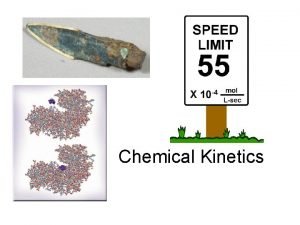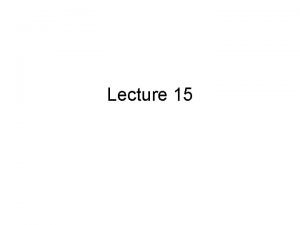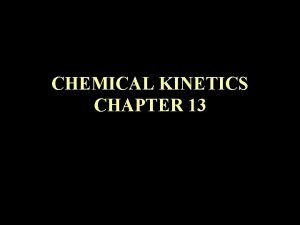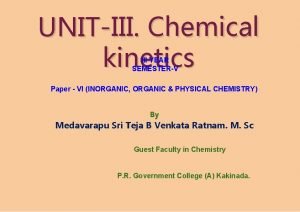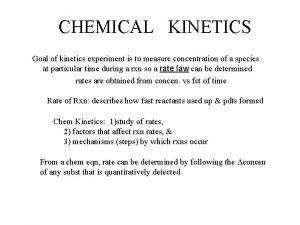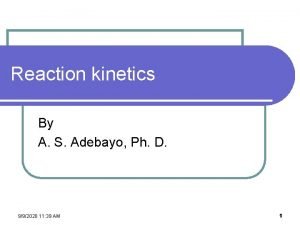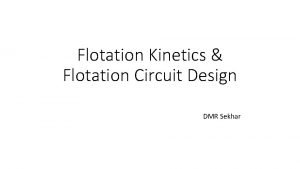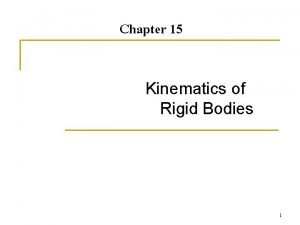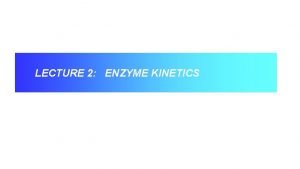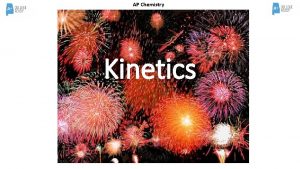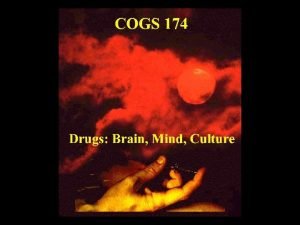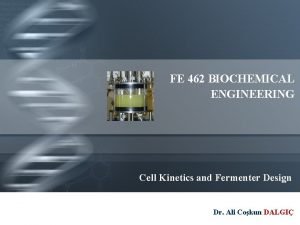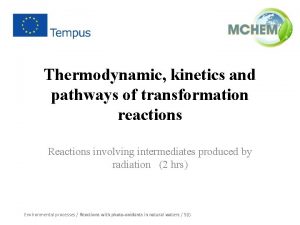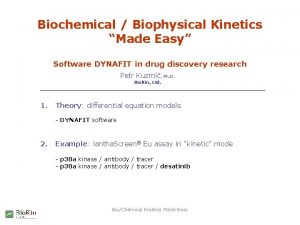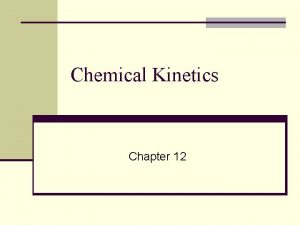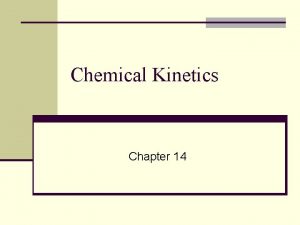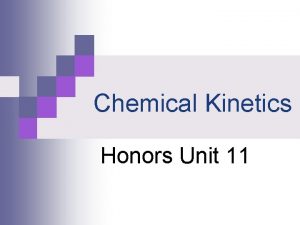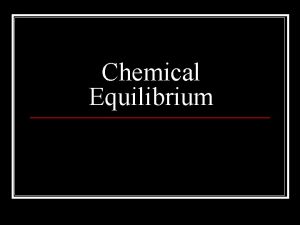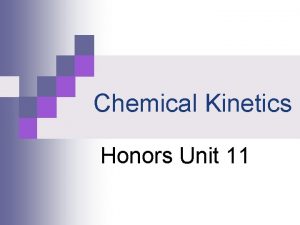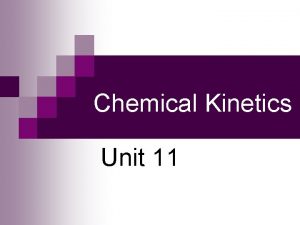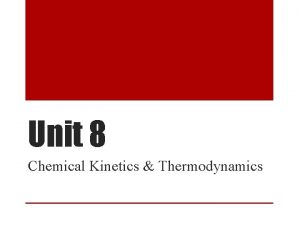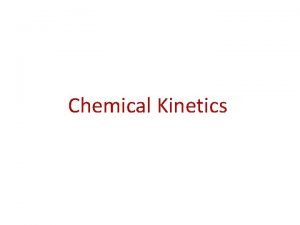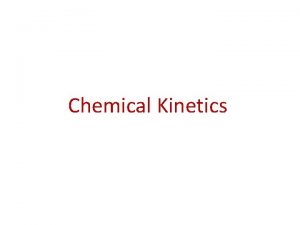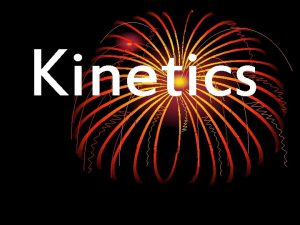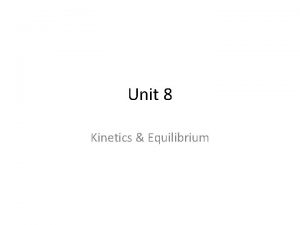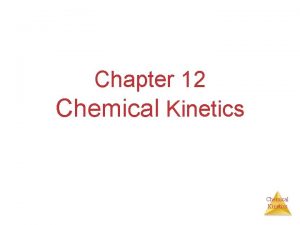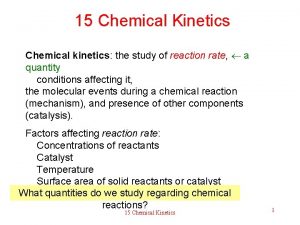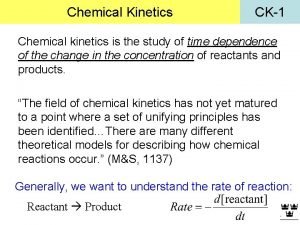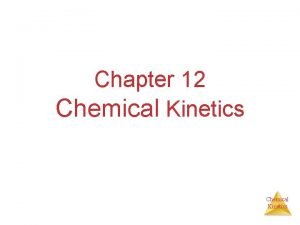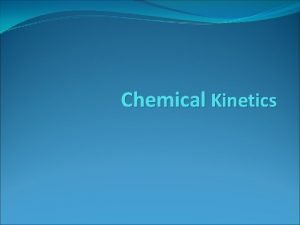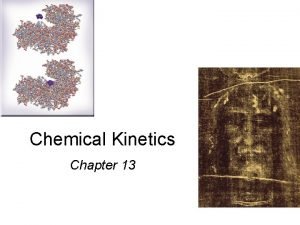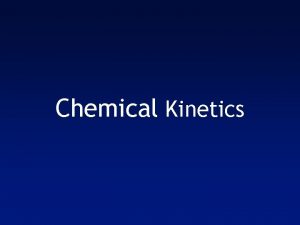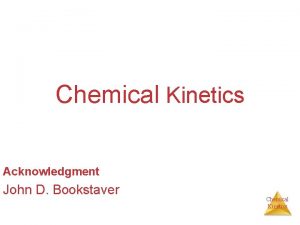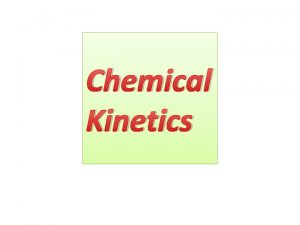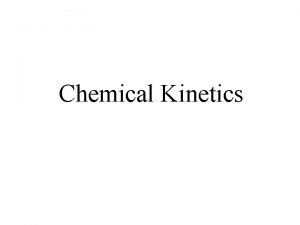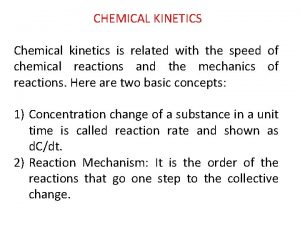Chemical Kinetics Chemical Kinetics Chemical kinetics is the
























































- Slides: 56

Chemical Kinetics

Chemical Kinetics Chemical kinetics is the study of: • the rates of chemical reactions • factors that affect these rates • the mechanisms by which reactions occur

Calculating Rates

Rates of Reaction Change in concentration of a species per unit time Example: rate of formation of product. A P Or … Appearance of product Disappearance of reactant Units: moles per liter per (unit of) time mol dm– 3 s– 1

2 H 2 O 2 2 H 2 O + O 2 1 L 2. 960 g O 2 (0. 09250 mole) produced in 60 s means … … 0. 1850 mol H 2 O 2 reacted in 60 s. 0. 1850 mol H 2 O 2/L Rate = 60 s = 0. 00131 M H 2 O 2 s– 1

2 H 2 O 2 2 H 2 O + O 2 If the rate of consumption of H 2 O 2 is 4. 6 M/h, then … … the rate of formation of H 2 O must also be 4. 6 M/h, and … … the rate of formation of O 2 is 2. 3 M/h

Average vs. Instantaneous Rate Instantaneous rate is the slope of the tangent to the curve at a particular time. We often are interested in the initial instantaneous rate; for the initial concentrations of reactants and products are known at this time.

Gas Collection Methods

Gas Collection Methods 4 g mol-1 He 28 g mol-1 Air Density = mass volume All gases occupy 22. 4 L at 25°C and 1 atm. Density is proportional to molar mass 80% N 2 44 g mol-1 CO 2

Gas Collection Methods

Gas Collection Methods

Gas Collection Methods

Gas Collection Methods

Measuring Rates

Methods to measure the rate of reaction If we want to understand how fast a reaction is happening we have to investigate the reaction as it is happening How much product is formed over a period of time? How much reactant is used up over time? The choice of method depends on the reaction

Methods to measure the rate of reaction State 3 methods to measure the rate of a reaction in which a gas is evolved.

Methods to measure the rate of reaction Explain how you would measure the rate of a reaction in which a precipitate is produced

Methods to measure the rate of reaction Directly measure the concentrations of products or reactants by titration • Take a sample of the reacting solution at specific time intervals • Stop or quench as quickly as possible • Titrate with a suitable standard solution Quenched by: 1. rapidly cooling in ice 2. removing the catalyst 3. removing one of the reactants by another chemical reaction 4. diluting with a large vol. of cold water

Methods to measure the rate of reaction Coloured reactions can be monitored using a spectrometer Spectrometers measure the amount of light absorbed or transmitted by a sample at selective wavelengths

Collision Theory

Collision Theory In order for reactions to occur particles must collide with each other in 1) The correct orientation 2) With sufficient energy Is this a successful collision?

Collision Theory - Orientation Not all collisions are successful

Collision Theory An Analogy for Reaction Profiles and Activation Energy

Collision Theory The configuration of the atoms at the time of the collision is called the transition state (activated complex) Activation Energy Heat (enthalpy) of reaction (DH)

Collision Theory – Activation Energy Ea Even highly exothermic reactions are not guaranteed to be fast! Why? Activation Energy � If a reaction is endothermic you must keep supplying heat � If the reaction is exothermic it Why does sugar in your sugar bowl not spontaneously burst into flames? releases energy and this energy can provide the activation energy for following reactions

Collision Theory To increase the rate of reaction requires. . . • more frequent collisions • increased particle speed • more particles present (a higher temperature) (a higher concentration) • more successful collisions • particles with more energy • a lower activation energy (a higher temperature) (use of a catalyst)

Factors affecting rates of reaction

Factors affecting rates of reaction • Concentrations of reactants: ↑Concentration = ↑Reaction rate • Solids = surface area • Liquids = concentration • Gases = pressure • Temperature: ↑Temperature = ↑Reaction rate • Catalysts: Catalysts = ↑ Reaction rate Inhibitors = ↓ Reaction rate Light can be a catalyst in some reactions. concentration pressure temperature surface area catalyst light

Concentration Liquids (concentration)

Factors affecting rates of reaction - Concentration Increasing concentration = more frequent collisions = increased rate of reaction Low concentration fewer collisions Higher concentration more collisions However, increasing the concentration of some reactants can have a greater effect than increasing others

Factors affecting rates of reaction - Concentration

Factors affecting rates of reaction - Concentration Reactions are fastest at the start Gradient = rate of reaction. . . why? A + 2 B C High concentration = more collisions CONCENTRATION C Low concentration = few collisions A B TIME

Factors affecting rates of reaction - Concentration Expt. run 3 times: (a) 2. 0 M HCl (b) 1. 0 M HCl (c) 0. 5 M HCl Mg(s) + 2 HCl(aq) Mg. Cl 2(aq) + H 2(g) Reaction rate: (a) > (b) > (c) 33

Concentration Gases (pressure)

Factors affecting rates of reaction - Pressure • ↑ pressure = gas particles closer together = ↑ concentration • ↑ frequency of collisions • many industrial processes occur at high pressure to increase the rate. . . but it can adversely affect the position of equilibrium and yield pressure ∝ 1/volume No effect on reaction with ONLY (s) and (l) because they are incompressible

Concentration Solids (surface area)

Factors affecting rates of reaction - Concentration More particles are exposed with smaller pieces, powdered solids react quicker than larger lumps. Catalysts (e. g. in catalytic converters) are finely divided for this reason In many organic reactions there are two liquid layers, one aqueous, the other non-aqueous. Shaking the mixture increases the reaction rate as an emulsion is often formed and the area of the boundary layers is increased giving more collisions. 1 CUT THE SHAPE INTO SMALLER PIECES 1 1 1 3 3 SURFACE AREA 9+9+3+3 = 30 sq units SURFACE AREA 9 x (1+1+1+1) = 54 sq units

Factors affecting rates of reaction - Concentration Ca. CO 3(s) + 2 HCl(aq) Ca. Cl 2(aq) + H 2 O(l) + CO 2(g) Reaction A is faster than reaction B a b 38

Temperature

Factors affecting rates of reaction - Temperature 1. ↑T ↑kinetic energies (speed) of reactant particles 2. ↑kinetic energies (speed) of reactant particles ↑ no. of effective collisions per unit time (↑ collision frequency & ↑proportion of high energy collisions) 40

Factors affecting rates of reaction - Temperature Na 2 S 2 O 3(aq) + 2 HCl(aq) 2 Na. Cl(aq) + SO 2(g) + H 2 O(l) + S(s) t = time taken for the disappearance of the cross rate 1/t Time t 2 < t 1 Rate 2 > 1 41

Light

Factors affecting rates of reaction - Light Consider the following reaction: C 6 H 14 + Br 2 C 6 H 13 Br ……… light (substitution reactions) Br 2 UV 2 Br· Reddish brown Colourless Light provides energy to split up Br 2 molecules into Br. radicals which are highly reactive. 43

Factors affecting rates of reaction - Light • shining a suitable light source onto some reactants increases the rate of reaction • the light - often U. V. - provides energy to break bonds and initiate a reaction • the greater the intensity of the light, the greater the effect Examples a) the reaction between methane and chlorine - see alkanes b) the darkening of silver salts - as used in photography c) the reaction between hydrogen and chlorine Equation H 2(g) + Cl 2(g) Bond enthalpies H-H Mechanism 2 HCl(g) 436 k. J mol-1 Cl-Cl Cl 2 2 Cl • H 2 + Cl • HCl + H • + Cl 2 HCl + Cl • 2 Cl • Cl 2 2 H • H 2 H • + Cl • HCl 242 k. J mol-1 ----- INITIATION ----- PROPAGATION ----- TERMINATION

Catalysts

INTRODUCTION • Catalyst = substance that speeds up reaction without undergoing any permanent change. • Often the catalyst is consumed in one step of the mechanism, but is regenerated in another step. • They provide an alternative mechanism with lower activation energy. © www. chemsheets. co. uk A 2 044 12 -Jul-12

INTRODUCTION

Types of catalysts Heterogeneous Homogeneous different state to the reactants same state as the reactants Adsorb (Surface) Absorb (Body)


HETEROGENEOUS CATALYSTS Hydrogen is adsorbed onto the surface of a nickel catalyst. A C=C approaches … … and is adsorbed. Hydrogen atoms attach to the carbon atoms, and the molecule is desorbed.

HETEROGENEOUS CATALYSTS Nature of catalyst • Large surface area. • Spread thinly over ceramic honeycomb.

HETEROGENEOUS CATALYSTS Nature of catalyst – Catalytic Converter • Large surface area. • Spread thinly over ceramic honeycomb.

HOMOGENEOUS CATALYSTS 1) Catalyst reacts with a reactant to form intermediate. 2) Intermediate reacts to form product faster than original reactant (and regenerates catalyst). e. g. acid catalyst X + Y products 1) X + H+ → HX+ 2) HX+ + Y → products + H+ © www. chemsheets. co. uk A 2 044 12 -Jul-12

HOMOGENEOUS CATALYSTS e. g. transition metal catalyst works by metal varying oxidation state Fe 2+ or Fe 3+ e. g. 2 I- + S 2 O 82 - → I 2 + 2 SO 42 - Slow because both –ve ions so repel. 1) 2 Fe 2+ + S 2 O 82 - → 2 Fe 3+ + 2 SO 42 - 2) 2 Fe 3+ + 2 I- → 2 Fe 2+ + I 2 © www. chemsheets. co. uk A 2 044 12 -Jul-12

Graphs Summary

Which graph is which? 2 g of Mg turnings + 50 cm 3 1 M HCl (excess) at 25°C 2 g of Mg ribbon + 50 cm 3 1 M HCl (excess) at 25°C 2 g of Mg powder + 50 cm 3 1 M HCl (excess) at 25°C 2. 5 g of Mg turnings + 50 cm 3 1 M HCl (excess) at 25°C X C B A
 Kinetic order
Kinetic order What is steady state kinetics
What is steady state kinetics Chemical kinetics definition
Chemical kinetics definition Molecularity of reaction
Molecularity of reaction Chemical kinetics experiment
Chemical kinetics experiment Chemical reactions grade 11
Chemical reactions grade 11 Applications of chemical kinetics
Applications of chemical kinetics Công thức tiính động năng
Công thức tiính động năng Thế nào là mạng điện lắp đặt kiểu nổi
Thế nào là mạng điện lắp đặt kiểu nổi Dạng đột biến một nhiễm là
Dạng đột biến một nhiễm là Biện pháp chống mỏi cơ
Biện pháp chống mỏi cơ Bổ thể
Bổ thể Vẽ hình chiếu đứng bằng cạnh của vật thể
Vẽ hình chiếu đứng bằng cạnh của vật thể Phản ứng thế ankan
Phản ứng thế ankan Thiếu nhi thế giới liên hoan
Thiếu nhi thế giới liên hoan Khi nào hổ mẹ dạy hổ con săn mồi
Khi nào hổ mẹ dạy hổ con săn mồi Chúa yêu trần thế alleluia
Chúa yêu trần thế alleluia điện thế nghỉ
điện thế nghỉ Một số thể thơ truyền thống
Một số thể thơ truyền thống Trời xanh đây là của chúng ta thể thơ
Trời xanh đây là của chúng ta thể thơ Số nguyên tố là gì
Số nguyên tố là gì Vẽ hình chiếu vuông góc của vật thể sau
Vẽ hình chiếu vuông góc của vật thể sau đặc điểm cơ thể của người tối cổ
đặc điểm cơ thể của người tối cổ Tỉ lệ cơ thể trẻ em
Tỉ lệ cơ thể trẻ em Các châu lục và đại dương trên thế giới
Các châu lục và đại dương trên thế giới Thế nào là hệ số cao nhất
Thế nào là hệ số cao nhất Hệ hô hấp
Hệ hô hấp ưu thế lai là gì
ưu thế lai là gì Môn thể thao bắt đầu bằng từ đua
Môn thể thao bắt đầu bằng từ đua Tư thế ngồi viết
Tư thế ngồi viết Cái miệng xinh xinh thế chỉ nói điều hay thôi
Cái miệng xinh xinh thế chỉ nói điều hay thôi Hình ảnh bộ gõ cơ thể búng tay
Hình ảnh bộ gõ cơ thể búng tay Cách giải mật thư tọa độ
Cách giải mật thư tọa độ Tư thế ngồi viết
Tư thế ngồi viết Voi kéo gỗ như thế nào
Voi kéo gỗ như thế nào Thẻ vin
Thẻ vin Thơ thất ngôn tứ tuyệt đường luật
Thơ thất ngôn tứ tuyệt đường luật Các châu lục và đại dương trên thế giới
Các châu lục và đại dương trên thế giới Từ ngữ thể hiện lòng nhân hậu
Từ ngữ thể hiện lòng nhân hậu Khi nào hổ mẹ dạy hổ con săn mồi
Khi nào hổ mẹ dạy hổ con săn mồi Diễn thế sinh thái là
Diễn thế sinh thái là Vẽ hình chiếu vuông góc của vật thể sau
Vẽ hình chiếu vuông góc của vật thể sau Slidetodoc
Slidetodoc V cc cc
V cc cc Phép trừ bù
Phép trừ bù Lời thề hippocrates
Lời thề hippocrates Tư thế worms-breton
Tư thế worms-breton đại từ thay thế
đại từ thay thế Quá trình desamine hóa có thể tạo ra
Quá trình desamine hóa có thể tạo ra Kinetics flotation chemicals
Kinetics flotation chemicals Kinematic of rigid body
Kinematic of rigid body Enzyme catalyze
Enzyme catalyze Ap chem kinetics practice problems
Ap chem kinetics practice problems Antagonistic effect
Antagonistic effect Cell kinetics and fermenter design
Cell kinetics and fermenter design Kinetics reaction
Kinetics reaction Dynafit kinetics
Dynafit kinetics
